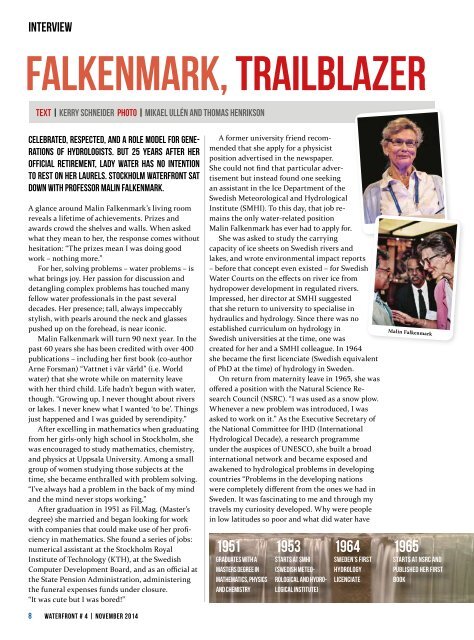Waterfront, #4, November 2014
You also want an ePaper? Increase the reach of your titles
YUMPU automatically turns print PDFs into web optimized ePapers that Google loves.
INTERVIEW<br />
FALKENMARK, TRAILBLAZER<br />
TEXT | kerry schneider PHOTO | Mikael ullén and thomas henrikson<br />
Celebrated, respected, and a role model for generations<br />
of hydrologists. But 25 years after her<br />
official retirement, Lady Water has no intention<br />
to rest on her laurels. stockholm WaterFront sat<br />
down with Professor Malin Falkenmark.<br />
A glance around Malin Falkenmark’s living room<br />
reveals a lifetime of achievements. Prizes and<br />
awards crowd the shelves and walls. When asked<br />
what they mean to her, the response comes without<br />
hesitation: “The prizes mean I was doing good<br />
work – nothing more.”<br />
For her, solving problems – water problems – is<br />
what brings joy. Her passion for discussion and<br />
detangling complex problems has touched many<br />
fellow water professionals in the past several<br />
decades. Her presence; tall, always impeccably<br />
stylish, with pearls around the neck and glasses<br />
pushed up on the forehead, is near iconic.<br />
Malin Falkenmark will turn 90 next year. In the<br />
past 60 years she has been credited with over 400<br />
publications – including her first book (co-author<br />
Arne Forsman) “Vattnet i vår värld” (i.e. World<br />
water) that she wrote while on maternity leave<br />
with her third child. Life hadn’t begun with water,<br />
though. “Growing up, I never thought about rivers<br />
or lakes. I never knew what I wanted ‘to be’. Things<br />
just happened and I was guided by serendipity.”<br />
After excelling in mathematics when graduating<br />
from her girls-only high school in Stockholm, she<br />
was encouraged to study mathematics, chemistry,<br />
and physics at Uppsala University. Among a small<br />
group of women studying those subjects at the<br />
time, she became enthralled with problem solving.<br />
“I’ve always had a problem in the back of my mind<br />
and the mind never stops working.”<br />
After graduation in 1951 as Fil.Mag. (Master’s<br />
degree) she married and began looking for work<br />
with companies that could make use of her proficiency<br />
in mathematics. She found a series of jobs:<br />
numerical assistant at the Stockholm Royal<br />
Institute of Technology (KTH), at the Swedish<br />
Computer Development Board, and as an official at<br />
the State Pension Administration, administering<br />
the funeral expenses funds under closure.<br />
“It was cute but I was bored!”<br />
8 WATERFRONT # 4 | november <strong>2014</strong><br />
A former university friend recommended<br />
that she apply for a physicist<br />
position advertised in the newspaper.<br />
She could not find that particular advertisement<br />
but instead found one seeking<br />
an assistant in the Ice Department of the<br />
Swedish Meteorological and Hydrological<br />
Institute (SMHI). To this day, that job remains<br />
the only water-related position<br />
Malin Falkenmark has ever had to apply for.<br />
She was asked to study the carrying<br />
capacity of ice sheets on Swedish rivers and<br />
lakes, and wrote environmental impact reports<br />
– before that concept even existed – for Swedish<br />
Water Courts on the effects on river ice from<br />
hydropower development in regulated rivers.<br />
Impressed, her director at SMHI suggested<br />
that she return to university to specialise in<br />
hydraulics and hydrology. Since there was no<br />
established curriculum on hydrology in<br />
Swedish universities at the time, one was<br />
created for her and a SMHI colleague. In 1964<br />
she became the first licenciate (Swedish equivalent<br />
of PhD at the time) of hydrology in Sweden.<br />
On return from maternity leave in 1965, she was<br />
offered a position with the Natural Science Research<br />
Council (NSRC). “I was used as a snow plow.<br />
Whenever a new problem was introduced, I was<br />
asked to work on it.” As the Executive Secretary of<br />
the National Committee for IHD (International<br />
Hydrological Decade), a research programme<br />
under the auspices of UNESCO, she built a broad<br />
international network and became exposed and<br />
awakened to hydrological problems in developing<br />
countries “Problems in the developing nations<br />
were completely different from the ones we had in<br />
Sweden. It was fascinating to me and through my<br />
travels my curiosity developed. Why were people<br />
in low latitudes so poor and what did water have<br />
1951<br />
Graduates with a<br />
Masters degree in<br />
mathematics, physics<br />
and chemistry<br />
1953<br />
Starts at SMHI<br />
(Swedish Meteorological<br />
and Hydrological<br />
Institute)<br />
1964<br />
Sweden’s first<br />
hydrology<br />
licenciate<br />
Malin Falkenmark<br />
1965<br />
Starts at NSRC and<br />
Published her First<br />
book


















